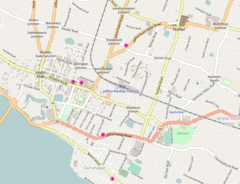Kruys Church or Kruys Kerk is located within the Jaffna fort in Jaffna, Sri Lanka and is situated near the entrance to the fort. The church was built by the Dutch in 1706 and was one of the oldest Protestant churches in the country.[1]
| Kruys Church | |
|---|---|
 | |
| Religion | |
| Affiliation | Dutch Reformed Church |
| Year consecrated | 1755 |
| Status | demolished |
| Location | |
| Location | Jaffna fort |
| Geographic coordinates | 9°39′44″N 80°00′33″E / 9.662257°N 80.009171°E |
| Architecture | |
| Type | Church |
| Style | Doric |
| Completed | 1706 |
| Website | |
| www | |
History
editKruys Kerk (Cross Church) constructed in the form of a Greek cross, in the south-eastern section of Jaffna fort. The church was erected in 1706, nearly half a century prior to the construction of the Wolvendaal Church in Colombo and the Groote Kerk in Galle, during the administration of Adam van der Duyn, the Commandeur of Jaffnapatnam. The architect and builder was Martinus Leusekam, who is described as a Baas Landmeter (Chief Surveyor) and the resident Predikant was Philippus de Vries.[2]
In September 1795 Jaffna fell to British forces. The church was then used as place of worship by the British garrison. The church gradually lost its congregation and in 1872 when the British began using their own church in the centre of Jaffna (1.5 km (0.93 mi) away), it was abandoned.
When the Liberation Tigers of Tamil Eelam occupied the fort during the Sri Lankan Civil War the church, along with a number of other key buildings, were demolished in an attempt to stop the Sri Lankan Army gaining control of the site.[3] Currently only the remains of the walls remain.[4] Fortunately a number of the historic tombstones were rescued and are currently housed at the church in Batticaloa for safekeeping.[5]
Architecture
editThe church was in the form of a Greek Cross, with arms of equal length and a wide central area. The walls were four to five feet thick, built out of rubble and coral stone, with a covering of cement. The pillars, arches and pediments of the doorways were built with imported Dutch bricks. The floor was paved with stones 2 sq ft (0.19 m2) in area, with a number of tombstones, dating from 1660, suggesting that they contained re-interred ashes or remains. The ends of the church's naves were gabled. The windows contained multiple panes and were heavily mullioned.[2]
The church could accommodate up to 600 worshippers.[2]
References
edit- ^ "Historic Buildings of the Dutch Reformed Church - The Kruys Church at Jaffna". Wolvendaal Foundation. Retrieved 15 May 2017.
- ^ a b c de Silva, R. Rajpal Kumar (1988). Illustrations and Views of Dutch Ceylon 1602-1796: A Comprehensive Work of Pictorial Reference With Selected Eye-Witness Accounts. Brill Archive. pp. 310–312. ISBN 9789004089792.
- ^ "Reconstruct not desecrate Jaffna landmarks". The Island. 25 November 2011. Retrieved 15 May 2017.
- ^ Ratnatunga, Kavan (19 October 2014). "On the Yal Devi to Yalpanam". Sunday Times. Retrieved 15 May 2017.
- ^ Sadanandan, Renuka. "Another look at Jaffna". Sunday Times. Retrieved 15 May 2017.
External links
edit- The Kruys Kerk of Jaffnapatam: (the Church in the Dutch Fort, Jaffna, Ceylon). Jaffna Christian Union. 1967.
- General Consistory - Dutch Reformed Church in Sri Lanka; Franciscus, S. Douglas (Ed) (1983). Faith of our Fathers: History of the Dutch Reformed Church in Sri Lanka (Ceylon). Pragna Publishers.
- Lewcock, Ronald; Sansoni, Barbara; Senanayake, Laki (2010). The Architecture of an Island - The Living Heritage of Sri Lanka. Barefoot. ISBN 9559466003.
